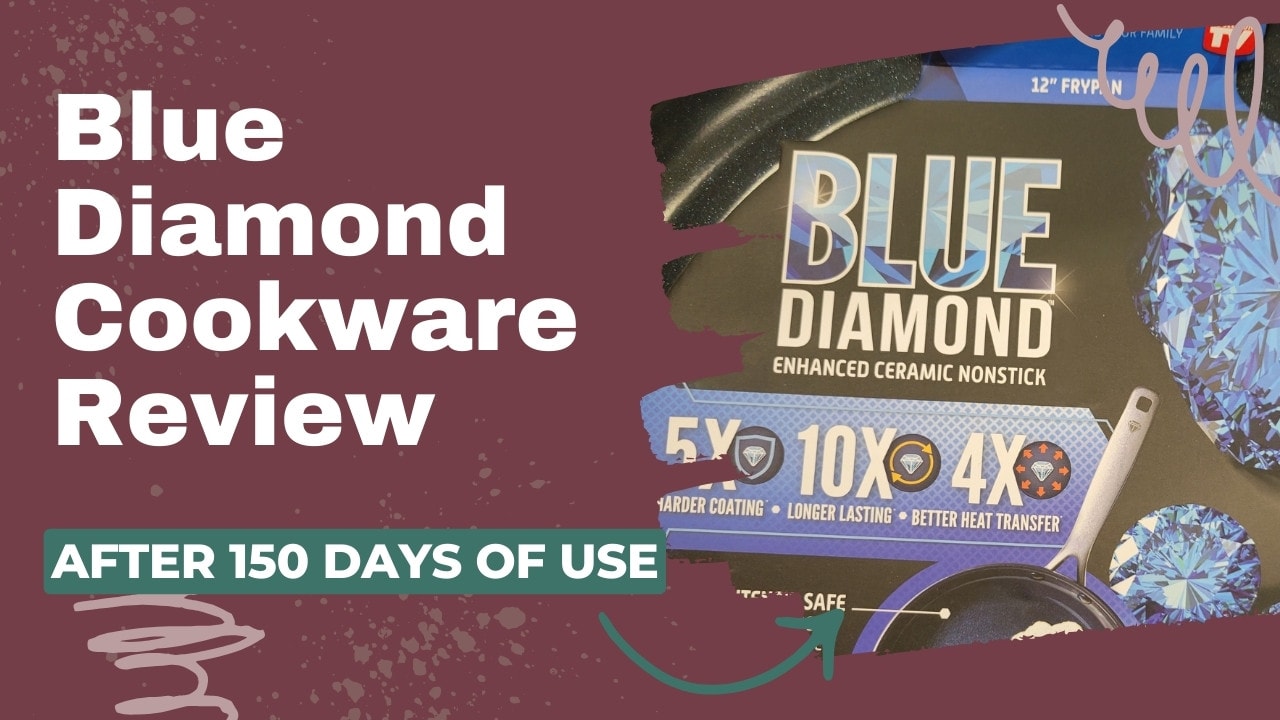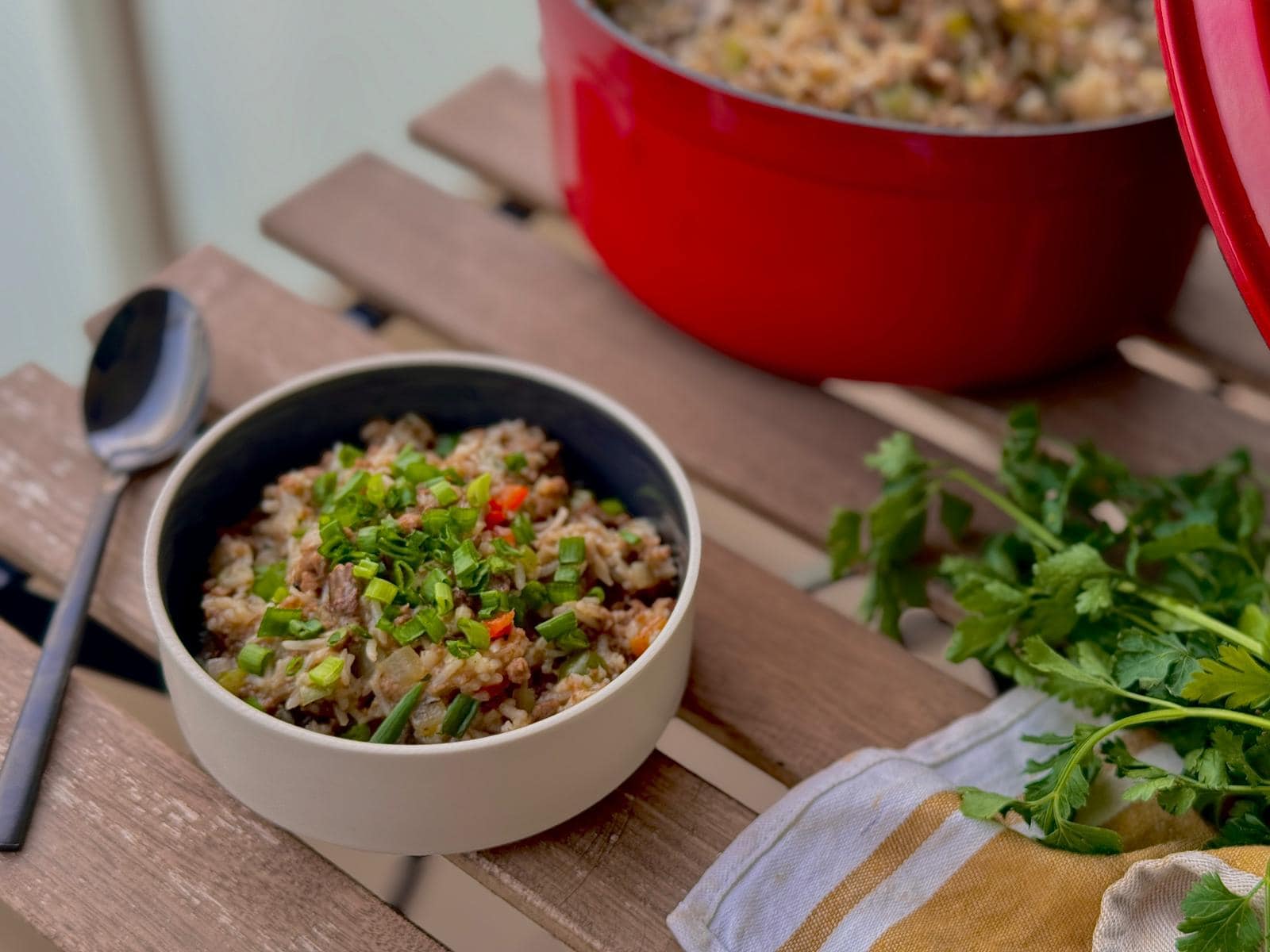I bought my mom millions of diamonds for Mother’s Day.
I mean.
I bought her a Blue Diamond pan.
On TV, the infomercial hosts claimed that it has millions of tiny diamonds infused into its nonstick surface.
We all know that diamond is among the hardest substances on earth. (About 5-10 times harder than the clay used in traditional ceramic pots, in case you were wondering.) So, surely, diamond-infused ceramic must be the key to a nonstick skillet that will last forever, right?
Well, my mom (and I, when I visit) have used that shiny sapphire pan every day for the last 5 months. This totally unbiased Blue Diamond cookware review is based on my experience cooking with that pan and comparing it to cookware of other brands and materials that I use and review daily.
Is Blue Diamond Cookware Worth the Money?
Yes. I believe that Blue Diamond fry pans – particularly the hard anodized aluminum models – are worth the money you pay for them. That’s because they’re not expensive to buy. You can get a full set of Blue Diamond pots, pans, and lids for less than $100.
If you’re willing to play nicely with this pan, hand wash it, and not use it with metal utensils or high heat – then a Blue Diamond skillet is a worthy addition to your kitchen.
But I could never get along using only this cookware. I need something more heavy-duty for my steaks and stir-fries! But sometimes, I just want something truly nonstick to fry up an egg or hash browns. This is why I keep a Blue Diamond ceramic skillet. (And yes, after using my mom’s for a while, I bought my own!)
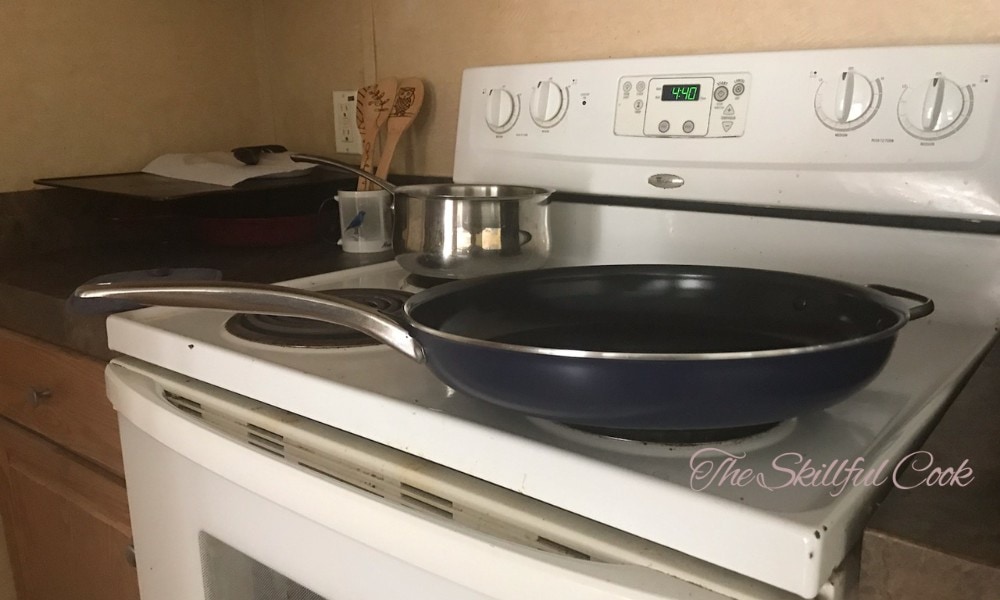
Blue Diamond Cookware Brand Pros and Cons
Pros
Cons
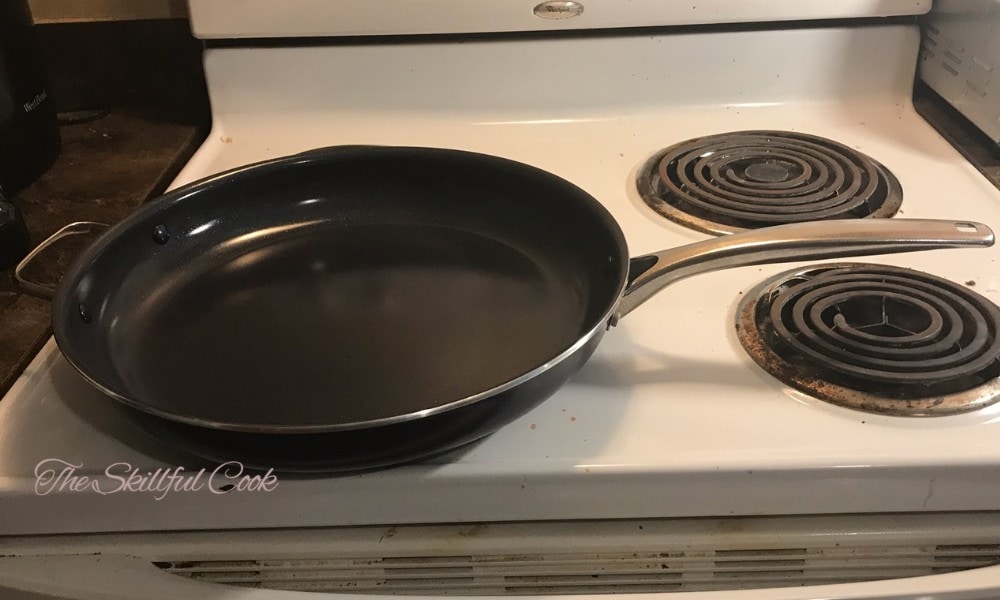
In short: Blue Diamond aluminum cookware is an affordable, lightweight alternative to traditional stainless steel or cast iron. It’s likely non-toxic, although more research is needed on the safety of ceramic coatings in general.
But is it the best cookware ever? Does it really last 10x longer than “other nonstick pans” like the marketing claims?
We’ll unpack the specific marketing claims later in this article. But my experience is that, no. This pan is no miracle. You get what you pay for with cookware– which is, in this case, usually 12-24 months of fun slippery nonstick use. After that, it will start to stick.
And if you overheat the pan when empty – even just once – that will bring an end to its stick resistance even faster.
Diamonds aren’t forever, after all. Especially not the $13 ones.
Blue Diamond Cookware Collections Compared
If you’re going into your purchase with realistic expectations and want to know which Blue Diamond collection is best for you, here’s an overview of your options.
At the time of writing, the Blue Diamond brand offers lots of sets and open stock pan options within several collections.
The various Blue Diamond collections available at the time of this writing are called:
This list of collections from the Blue Diamond company website is a lot longer than you would think after exploring the product lines on Amazon. That’s because there’s really not much difference between a lot of those collections. On Amazon, many of those are listed as variants of the same product. So let’s pare that list down a bit.
Green Diamond, Pink Diamond, and Red Diamond collections are simply color variants of the original Blue Diamond pans. There’s no other difference. They are classic aluminum pans with the standard Blue Diamond brand coating.
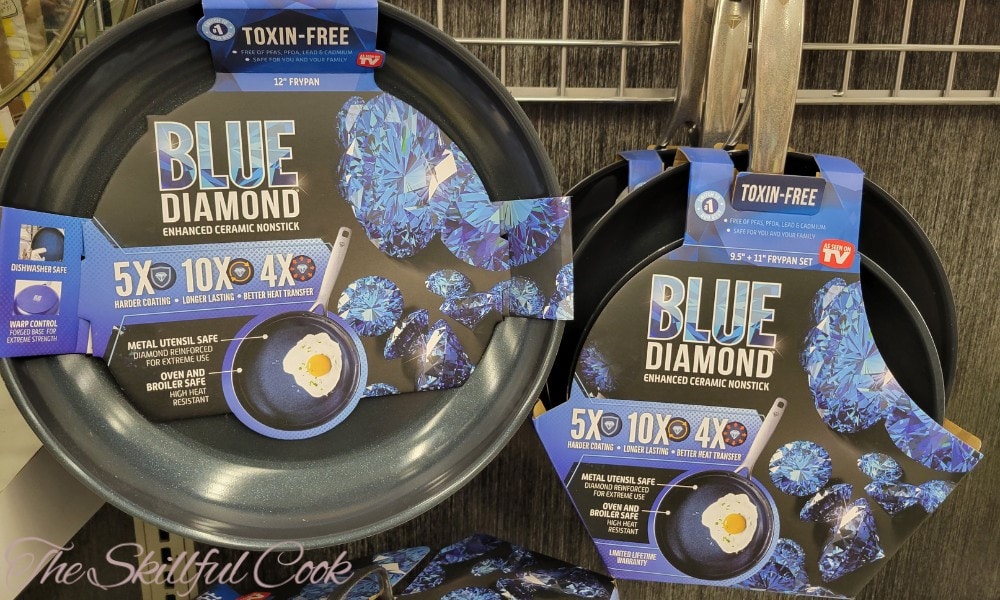
The Blue Diamond Induction pans are also pretty standard aluminum pans, but since aluminum isn’t a ferrous material and won’t work on induction stoves, these pans must have a layer of steel set into the base. This probably makes them slightly sturdier and less prone to warping than the Classic collection – but only slightly.
The Blue Diamond Clad Pro and Triple Steel collections both feature fully-clad stainless steel pans with the standard ceramic coating. What’s the difference between those two collections? Pan thickness, coating color, and price. But there’s not a lot of difference, so we’ll review those two sets together.
| Features | Blue Diamond Classic Aluminum (with Green Diamond and Induction Options) | Blue Diamond Hard Anodized Pro | Blue Diamond Gold | Blue Diamond Stainless Steel |
|---|---|---|---|---|
| Price: | 💲(Check Today’s Price) | 💲💲(Check Today’s Price) | 💲💲(Check Today’s Price) | 💲💲(Check Today’s Price) |
| Star Rating: | 4.0 ⭐️ | 4.5 ⭐️ | 4.8 ⭐️ | 4.2 ⭐️ |
| Surface Material: | Colored ceramic (sol-gel) coating with diamond dust | Colored ceramic (sol-gel) coating with diamond dust | Colored ceramic (sol-gel) coating with diamond dust | “Midnight” ceramic (sol-gel) coating with diamond dust |
| Core Material: | Aluminum | Hard Anodized Aluminum | Aluminum | Tri-ply stainless steel |
| Colors: | Blue, green, red, pink with silver | Blue and silver | Black and gold | Dark blue and silver |
| Oven Safe: | Yes to 600°F | Yes to 600°F | Yes to 600°F | Yes to 600°F |
| Induction Compatible: | Not standard, but induction option available | No | Yes | Yes |
Blue Diamond Classic Aluminum (with Green Diamond and Induction Options)
With the original Blue Diamond coating, these are the famous sparkly pans you saw in the TV commercials. They are lovely to look at and to cook on, since the lightweight aluminum heats quickly. But I found that it doesn’t disperse the heat across the pan very evenly.
If I use a little oil, eggs do slide off my Blue Diamond pan. I find that using a little oil regularly prevents sticking and scrubbing, which will make the pan last longer in the end. You can find full descriptions of my tests on this pan later in this article.
The classic collection products are the most affordable Blue Diamond pans, but they probably also have the shortest lifespan. While they still have a “forged base,” the cores aren’t as thick and sturdy as the hard anodized or stainless steel versions of the pan, making them susceptible to warping. Many users report the pan warping under high oven heat or if they run a hot pan under cold water.
If you’re purchasing this pan on Amazon, be careful to select all the options that you need. It is sold on Amazon with induction compatibility as an option, as well as a choice of colors. Although sometimes the green versions are referred to as “Green Diamond pans,” this teal-emerald line of cookware is simply a color variant of Blue Diamond pans.
Quick Overview:
Pros
Cons
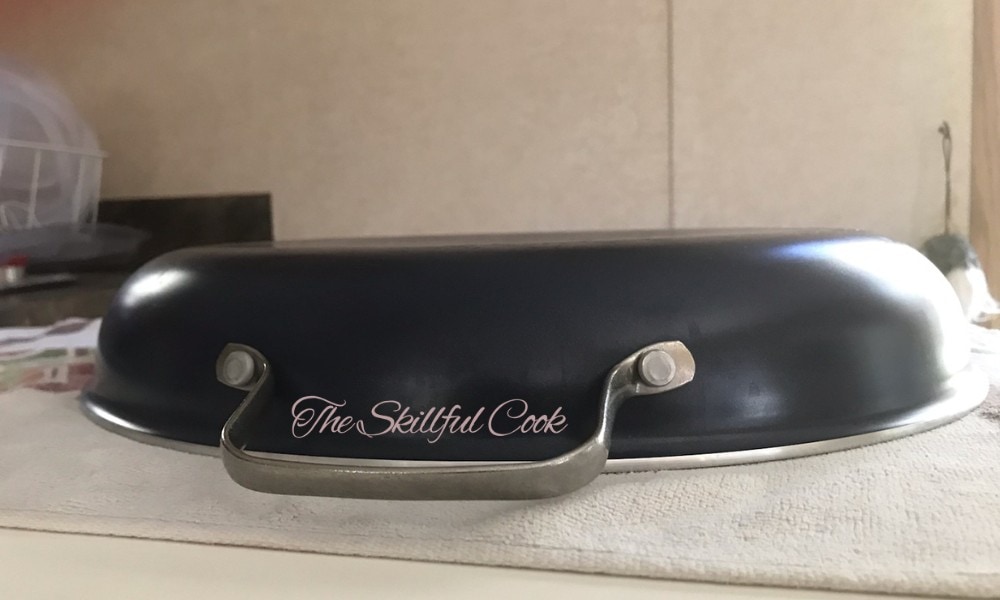
Image slightly concave or bowed bottom of the pan means it doesn’t make full contact with electric stoves.
Blue Diamond Hard Anodized Pro
Hard anodized aluminum has undergone an electrochemical process to make it harder and more durable. So the marketing claims that the Blue Diamond Hard Anodized Pro pans are 11x harder than the classic line are probably true, even though that sounds like a lot.
It doesn’t mean they’ll last 11 times as long, but they may last twice as long as the classic line, like the advertising says they will. These pans will definitely resist warping and denting much better, and being slightly thicker, they retain heat better as well.
It’s hard to tell from the company literature, but I believe the coating on the hard anodized pans is the same as the coating on the standard pans, not extra-reinforced. The advantage to these over the classic pans is all in the body of the pan, not that coating.
The disadvantages of the hard anodized pans is that they are more expensive, not induction compatible, come in fewer colors, and come in fewer options. At the time of writing, you can buy a couple of skillets individually, but if you want a hard anodized Blue Diamond pot, you need to buy the full 10-piece set.
Quick Overview:
Pros
Cons
Blue Diamond Gold
The Blue Diamond Gold has an upgraded body, additional layers of coating, and an updated color scheme compared to the classic line. The jet-black ceramic coating and gold finish might look a bit gimmicky to some, but I’m a sucker for it.
The company claims to have tested the Gold pans against their original line and found them to be 50% tougher and 90% more dishwasher-safe. This, to me, confirms that you shouldn’t put the classic pans in the dishwasher at all and should think real hard about putting these beauties into the dishwasher, too.
The emphasis on hardness is so intense in the marketing that it makes me wonder if the coating on these pans would be brittle and more susceptible to thermal shock. The main reason that nonstick coatings (whether ceramic or traditional) wear down is that they don’t expand and contract as they heat at the same rate as the metal they’re attached to. This stress causes micro-tears in the coating over time. Would a very very hard coating make this more likely to happen? These Blue Diamond Gold pans are new to the market, so only time will tell.
The Gold line is made of aluminum (not hard anodized), but they do have an induction plate fastened to the bottom.
Quick Overview:
Pros
Cons
Blue Diamond Stainless Steel
If you want the Blue Diamond ceramic coating on a stainless steel base, you have two options: the HD Clad Pro collection and the Triple Steel collection, known as the Tri-Ply collection on Amazon.
Both collections have an aluminum core covered on the inside and out with a layer of stainless steel. These steel pans have the advantage of being much more durable and longer-lasting than their aluminum counterparts. They won’t heat up as quickly, which could be an advantage or disadvantage, depending on your cooking style.
But when I say that the pan is more durable than aluminum, I’m referring to the base of the pan itself, not the coating. The Triple Steel collection has the exact same ceramic coating as the aluminum collection so it won’t last any longer. In fact, since stainless steel pans can last decades, but the coating has a life expectancy of less than two years, a stainless steel pan with a ceramic coating doesn’t make a lot of sense, in my opinion.
Quick Overview:
Pros
Cons
The Marketing Claims
What do all the Blue Diamond collections have in common?
Clever copywriting.
As a writer, I’d love a client that would let me get away with sentences like, “With careful craftsmanship, dynamite durability….Blue Diamond continues to reign supreme.”
But as a researcher, it’s frustrating to see facts hidden behind marketing claims that are obviously worded to distract and dazzle.
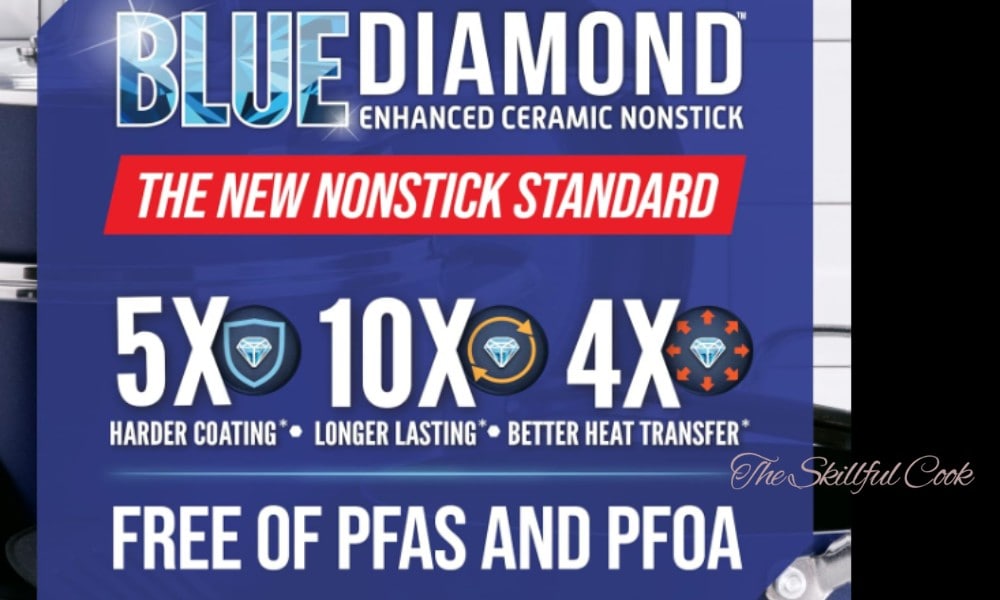
“4x Better Heat Transfer”
Most blatantly eye roll-inducing is the claim – printed boldly on all the product packaging – of 4x better heat transfer. We need to ask, 4 times better heat transfer than what?
Well, if you read the fine print, it says, “Diamonds are 4x more conductive than copper, so Blue Diamond heats up faster and cleans up easier.”
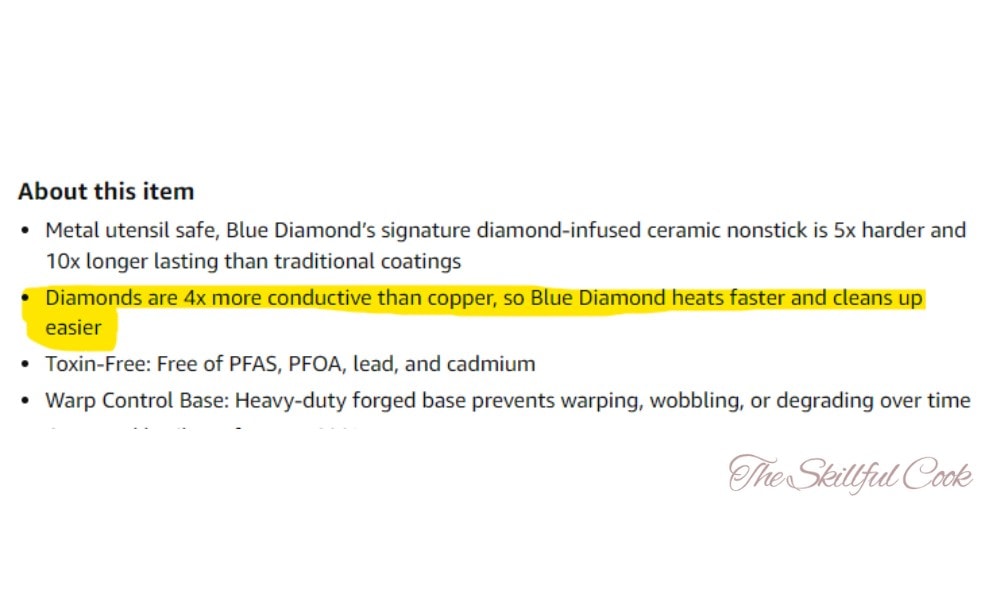
That, my friends, is not sloppily-worded copy, as it first appears. That is bait and switch marketing.
The claim that Diamonds are 4x more conductive than copper is true. According to ThermTest Instruments, diamond, as a material, is up to 5x more electrically conductive than copper!
But let’s look at the claim again. “Diamonds are more conductive than copper” does not equal “so Blue Diamond heats faster and cleans easier.” Heats faster and cleans easier than what? The intentional non sequitur here is meant to distract you; it definitely does not mean that your $29 Blue Diamond skillet will heat faster or perform better than a $249 copper fry pan – because it totally won’t.
“5x Harder Coating”
The 5x harder coating claim may be the most legitimate of them all – although it’s probably not due to the diamond dust. While diamond is one of the top-5 hardest materials known to man, the amount of diamond dust sprinkled into the ceramic coating in a Blue Diamond pan is probably not significant enough to make a difference in its performance.
Still, The Cookware Company has been developing nonstick ceramic since 2007 and is truly a leader in making durable sol-gel coatings. While some users report chipping and scratching on Blue Diamond cookware right out of the box – especially around the pan edges – my pan hasn’t chipped at all in 5 months.
In the video below, a user reproduced a marketing stunt from a Blue Diamond commercial and used a handheld electric beater on his pan. The beater did chip the pan’s coating – but honestly not as much as I’d expect.
So the claim that the Blue Diamond coating is “5x harder than traditional nonstick cookware” is probably true, at least compared to cheap, single-layer Teflon-coated pans.
“10x Longer Lasting”
When you have a company that has a whole page on its website for the fine print, you might want to approach it with skepticism.
The claim that Blue Diamond pans are 10x longer lasting than cheap thin aluminum pans may also be true and is supposedly based on testing from CSA Group in May 2018.
But some of the commercials for Blue Diamond have claimed that traditional nonstick cookware lasts “a month.” If that’s the case, then, sure – you can reasonably expect to get 10 months out of your Blue Diamond pan. The product does have over 36,000 Amazon reviews, and over 80% of them are positive. So a lot of people – especially those with reasonable expectations – appear to be happy with the product.
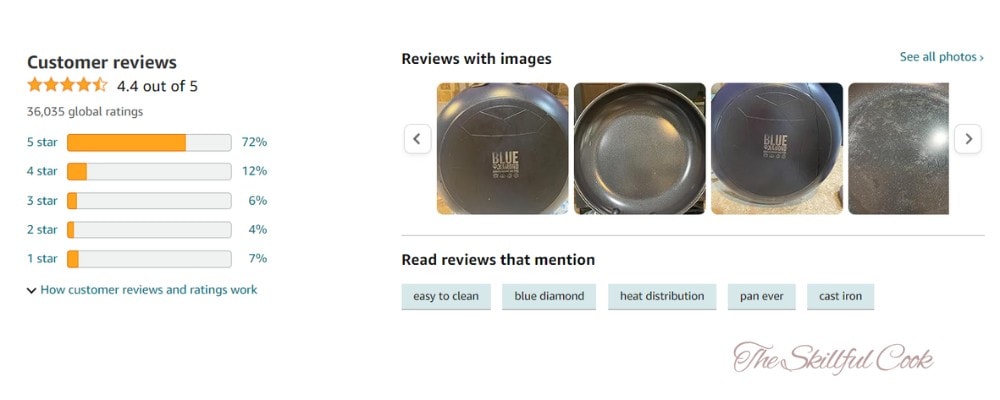
Just remember that the company that owns Blue Diamond has been under heat before for its far-fetched marketing claims. In 2012, the National Advertising Division of the Better Business Bureau called the company out on its over-the-top statements regarding its GreenPan brand.
Is Blue Diamond a Good Brand?
Blue Diamond is a brand of The Cookware Company, founded in Belgium with US offices in Irvington, New York. It's the manufacturer of several of the most popular ceramic-coated pans, including GreenPan, GreenLife, and GreenChef. GreenPan was, in fact, its first offering when the company began in 2007.
So if you’re looking to compare GreenPan vs Blue Diamond, you should know that both brands are made by the same company and use the same ceramic coating technology as a base before putting their respective spins on it.
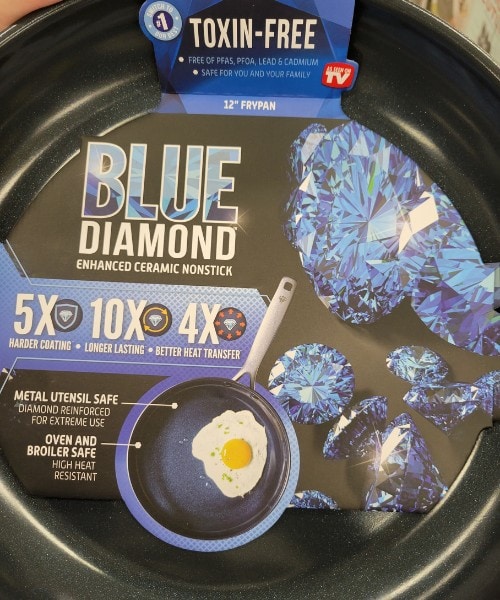
All of the Blue Diamond pans are manufactured in China.
In short, Blue Diamond is a good brand – if you’re looking for a manufacturer with a lot of experience in ceramic nonstick coatings. In fact, the powerhouse marketing team behind GreenPan and Blue Diamond is a huge factor in driving the recent popularity of ceramic-coated pans in general.
But is it a super ethical or transparent company? No, nothing makes me think that it is. In fact, following the 2019 class action lawsuit against GreenPan, many experts and bloggers have accused the company of “greenwashing” and pointed out that The Cookware Company does not publish much third-party verification of its gigantic marketing claims.
What are Blue Diamond Pans Made of?
Most Blue Diamond pans have aluminum cores with stainless steel handles. The brand also makes tri-ply stainless steel pans. All Blue Diamond pans are coated with a sol-gel ceramic coating derived from silica and infused with diamond dust. The company does not reveal the exact composition of its ceramic coatings.
Are Blue Diamond Pans Non-toxic and Safe to Cook On?
The Blue Diamond brand – along with GreenPan and GreenLife pans from the same manufacturer – claims that its nonstick ceramic coating is non-toxic and free of PFOA. Interestingly, the Blue Diamond brand doesn’t make health-related claims the main thrust of its marketing.
In the previous decade, GreenPan’s marketing convinced the world that ceramic-coated pans are much safer to use than traditional nonstick. However, the downside to ceramic coatings is that they wear off notoriously quickly.
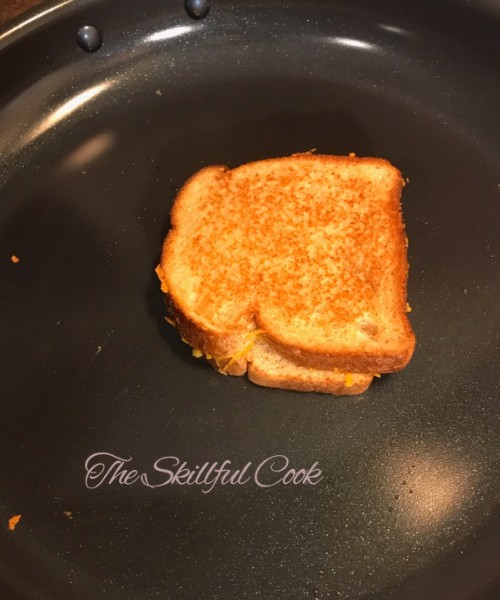
So, enter Blue Diamond – simply a rebrand of GreenPan’s Thermolon™ coating with added diamond dust1. Blue Diamond is riding the wave of public opinion that already believes ceramic coatings are healthy, and the brand is trying to convince people that its ceramic coating will last longer than all the other kinds.
Since The Cookware Company was publicly scolded in the past for saying their pans are “healthy,” the Blue Diamond company doesn’t make that specific claim. They do say that their pans are “Toxin-Free: Free of PFAS, PFOA, lead, and cadmium.”
The “toxin-free” claim always makes me raise an eyebrow. So many elements are potential “toxins” that they can be found in almost every kind of cookware – including ceramic.
The Blue Diamond website states, “Our diamond-infused ceramic nonstick has also been certified by third-party testing labs as conforming to international regular food contact standards set by the US FDA (USA Food & Drug Administration) and by EU regulators.”
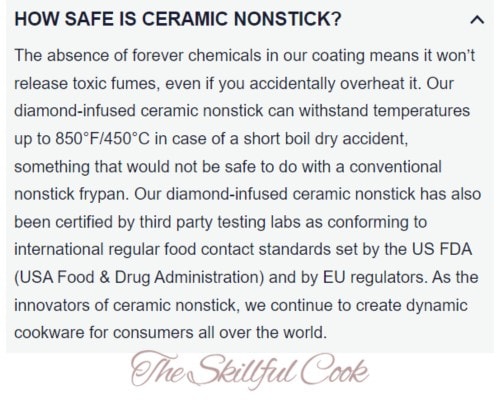
I was not able to find published links to those studies – and I don’t think the company publishes them.
But most ceramic-coated pans are free of lead and cadmium -- so we can assume Blue Diamond is as well. And ALL pans sold in the US have to be free of the carcinogenic PFOA (perfluorooctanoic acid) – including Teflon pans – since PFOA was banned in 2015. Blue Diamond’s ceramic coating does not contain synthetic polymers like Teflon or the “forever chemicals” used in manufacturing PTFE.
Are there health concerns with ceramic coatings? Yes, some. Some experts are concerned about nanoparticles entering the body through scratched ceramic coatings.
The titanium and quartz nanoparticles used in nano-ceramic sol-gel technology can penetrate lung tissue more readily than larger particles.
At present, most doctors and health experts publishing in the cookware space regard ceramic pans as “probably safe,” but they caution that more research is needed to understand this relatively new technology.
Blue Diamond Pan Review
My mom has the Blue Diamond 14” Skillet with Helper Handle, and she uses it as her everyday pan for cooking everything from eggs to her famous steak medallions. It’s held up remarkably well with this treatment, even on her harsh electric stove.
So, while I consider Blue Diamond’s marketing claims to be borderline fallacious, the product itself is actually very good quality for the cost.
Put simply, I like using Blue Diamond pans.
I reserve my Blue Diamond skillet for light cooking, such as warming leftovers or making a grilled cheese sandwich, to keep the coating intact as long as possible. But I put my mom’s 14” pan to a rigorous test (with her approval) when I went to visit. Here’s what I found.
Test 1: Eggs
It’s very easy to fry an egg in a Blue Diamond pan. Unlike stainless steel pans, aluminum heats up quickly and does not need a lot of preheating. In fact, you should avoid preheating it when empty for more than 30 seconds or so because overheating can quickly destroy its nonstick coating.
Cooking an egg was extremely simple. With oil, there was no sticking at all. Without it, there wasn’t much sticking – and this was after the pan had been used for 6 months.
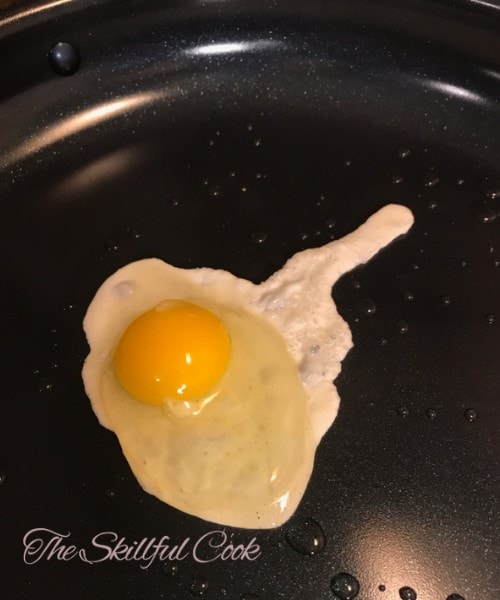
Test 2: Pancakes
Pancakes on the Blue Diamond pan were also a success – but revealed that this large 14” skillet didn’t heat as evenly as I would have expected.
When I used a few drops of oil (not cooking spray!) the pancakes flipped easily and slid around without sticking. They did pretty well without any oil, too – at least near the center of the pan.
The pancakes that were near the outer edges of the pan were unevenly cooked. They browned where they neared the center of the pan well before the side of the pancake that extended towards the edge of the pan was done enough to flip.
This made me suspect that the pan didn’t distribute heat very well. The next test confirmed it.
Test 3: Boiling Water
We use the water boil test to check how fast a pan gets hot and how evenly it spreads the heat. It also helps us see how well the pan handles being hot for a long time.
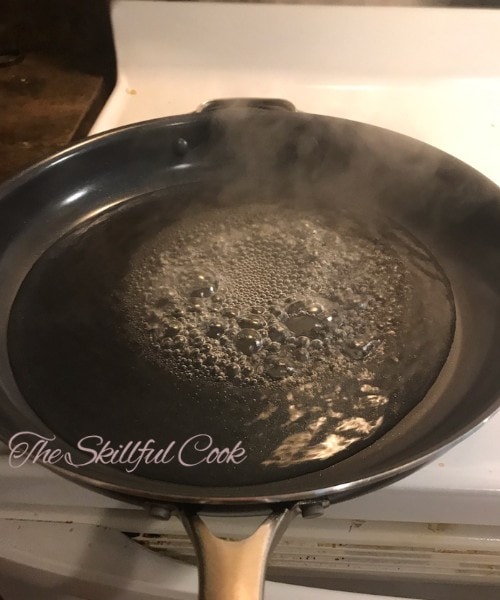
On my mom’s electric stove, two cups of water in the 14” aluminum pan came to a boil quickly – but very unevenly. As you can see in the photo, the “donut” shape in the center of the pan reveals that the pan heats very fast in the center, but doesn’t spread the heat out to the sides of the pan very well.
I would be interested to try this test with a hard anodized or Blue Diamond Gold pan to see if their thicker bases heat more evenly.
Test 4: Searing and Sauteing
That hot spot in the center of the Blue Diamond pan made it very effective at cooking steak for dinner – as long as the steak stayed near the middle of the pan!
Near the center of the pan, the steak developed a nice crust. Near the edges of the pan, it stuck – but not immovably.
I have also browned meat and made stir fry in this pan. I’ve found that for those applications, it does pretty well. You’re moving the protein around as you cook, so it all has a chance to get into the hotter sections of the pan.
None of the proteins I cooked in the pan stuck very much, and all of them were easy to clean out with a soft sponge and mild detergent. It was way easier to clean this pan than it is to clean my cast iron skillet when I brown meat in it! So give Blue Diamond points for that.
Note: Handles Get Hot!
The biggest drawback to searing on this pan is that the handles get HOT! And they get hot quickly. They are made of stainless steel, which shouldn’t heat up as quickly as aluminum, but the handle design doesn’t help.
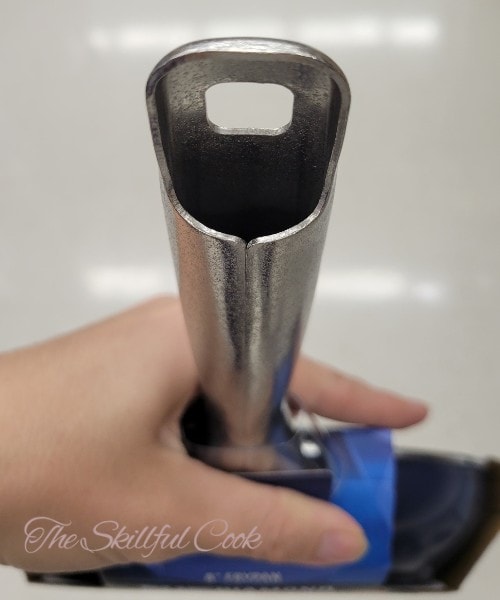
The handles don’t have the V-shaped attachment that some brands use to reduce heat transfer to the handle. And the handles are also hollow – which sounds like a good idea, but it actually serves to funnel hot air through the handle. If the handles were solid stainless steel, it would actually disperse heat more quickly.
Design and Aesthetics
I like the jewel tones of the Blue Diamond pans. Not everyone does. Some vocal Youtubers think they look tacky. The aesthetic of Blue Diamond pans definitely doesn’t communicate industrial-quality cookware like polished stainless steel does. But the shiny metallic rims and deep colors definitely catch your eye.
Does the color hold up with use? Yes, it does. Because unlike the Rachael Ray pan I reviewed, the pigment on these pans feels more like it’s worked into the material, not a superficial coat of enamel paint.
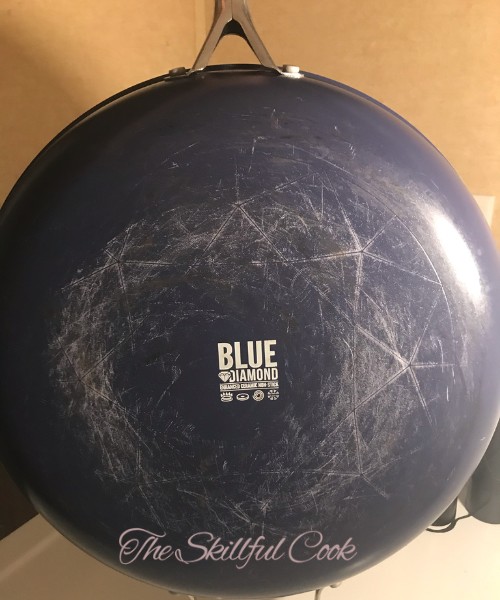
The paint on my pan did scratch on the electric coil, but it didn’t bubble or peel. The scratches are only on the bottom of the pan and not visible when cooking with it.
Materials and Construction
The Blue Diamond brand hit the market via TV infomercials about five years ago. But its manufacturer, The Cookware Company, is not a newbie to ceramic cookware. According to its website, The Cookware Company was actually the first to introduce ceramic-coated nonstick pans to consumers.
With wildly successful brands like GreenPan and GreenChef, The Cookware Company knows how to make a fine-tuned piece of ceramic cookware. Blue Diamond does not advertise that it uses The Cookware Company’s patented Thermolon coating, but if you dig into its warranty page, you’ll find that it does!
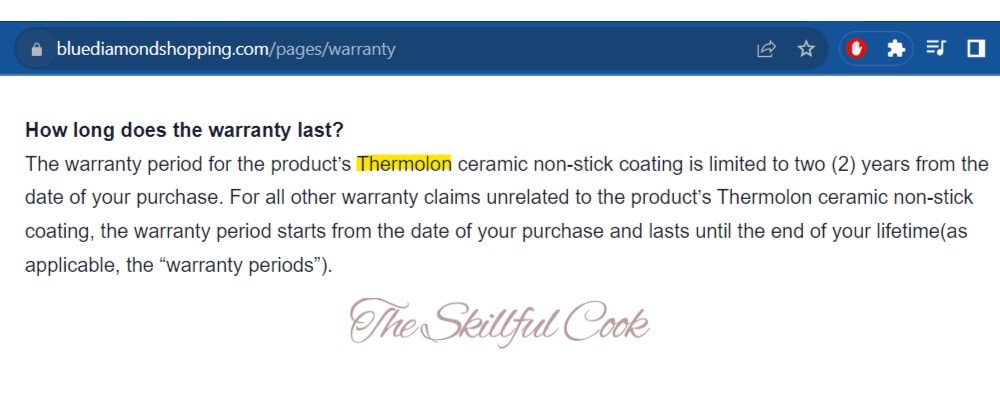
Notice that while the body and handle of the pan have a limited lifetime warranty, the Thermolon nonstick coating only comes with a two-year warranty!
Like other ceramic coatings, the Blue Diamond coating is made from sand-derived silicon dioxide.
Comfort and Ease of Use
The Blue Diamond pans get points for being lightweight and easy to handle. But, as I described earlier, the handles get very hot. This is probably the biggest drawback to using these pans.
Ease of Maintenance and Cleaning
One of the major selling points of this pan in its marketing is that it’s dishwasher safe. But, if you read the insert that comes with the product, you’ll see it recommends hand washing to prolong the life of the pan.
The Blue Diamond Gold line claims to be 90% more resilient to dishwashers than classic Blue Diamond pans. Maybe I’ll get a Gold pan and review it next time!
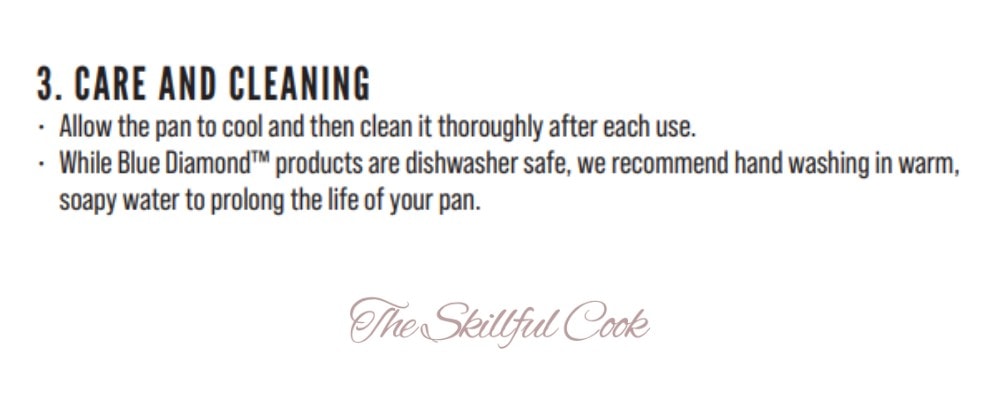
Thankfully, for the first several months that you use this cookware, it should stay nonstick enough to make handwashing with a soft sponge and warm water quick and painless.
Over time, your pan will begin to stick and be more difficult to clean. Be careful, though, because the harder you scrub it, the more you’ll damage the coating.
I also found this great cleaning tip on a YouTube review of the product. The user reached out to the company after his pan developed discoloration and started to stick. The company suggested boiling hot water in the pan and cleaning it with a magic eraser sponge. He says the pan’s nonstick abilities were restored!
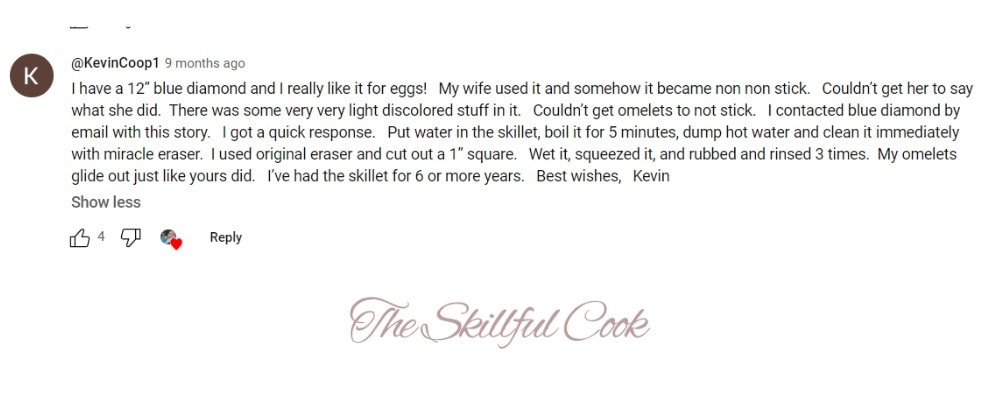
Versatility
No ceramic skillet will ever be the most versatile pan on your rack. The advertising says that harsh treatment from 600°F oven heat, metal utensils, and dishwashers won’t hurt your Blue Diamond pans.
But when you read the product manual, you get a truer tale. It says that “low to medium heat settings are recommended for most cooking.” Although it also says that (unlike Teflon nonstick pans) a Blue Diamond pan can “withstand accidental overheating up to 850°F” without releasing fumes that could be harmful to you or your pets.
Longevity and Warranty
The Blue Diamond pan I tested in this review is still going strong after 5 months of heavy use.
But I don’t expect that to continue for years.
As I mentioned above, Blue Diamond only offers a 2-year warranty on its nonstick coating – even though it buries that fact under claims of a “90-day guarantee” and a “limited lifetime warranty” against manufacturing defects.
And if you look at reviews on Reddit, Amazon, or YouTube, you’ll see lots of reviews that prove these pans usually wear out within two years.
Even the product insert says, “After a while, there is a natural reduction of the nonstick properties. This process is accelerated by prolonged exposure of the nonstick surface to the high heat, which causes the carbonization of food and oil.”
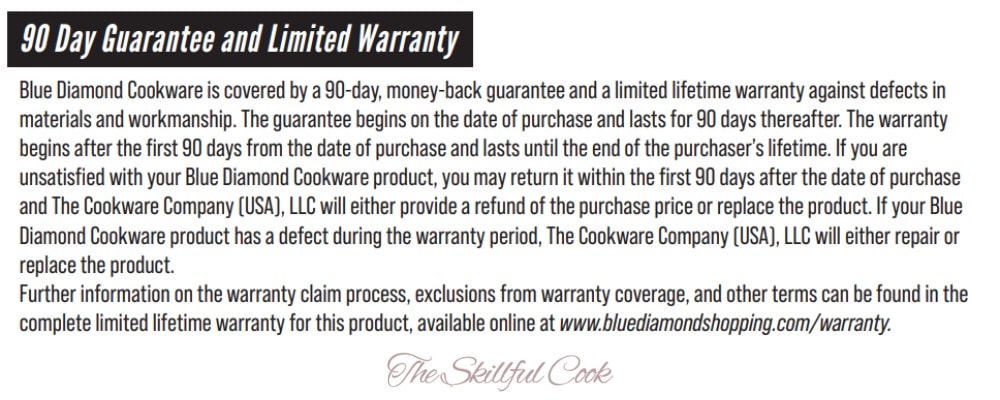
In Conclusion
In summary, you get what you pay for with Blue Diamond cookware – and that’s not a bad thing.
But don’t expect too much from Blue Diamond cookware. The warranty on its Thermolon coating is only good for two years, and it won’t hold up to intense cooking. For a truly versatile cookware set that can do everything from steaks to French omelets, you should give stainless steel a try.
Blue Diamond Cookware
For an affordable price, you can get a reliable set of everyday nonstick pans that dress up your stove and don’t contain scary “forever chemicals.” Overall, I liked Blue Diamond pans a lot better than competitors like Gotham Steel.
- Several of the newer GreenLife and GreenPans by the same manufacturer also contain diamond dust, so they probably have identical coatings to Blue Diamond cookware. Example: GreenLife Soft Grip Diamond Healthy Ceramic Nonstick ↩︎

